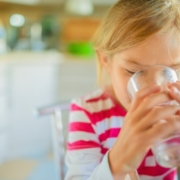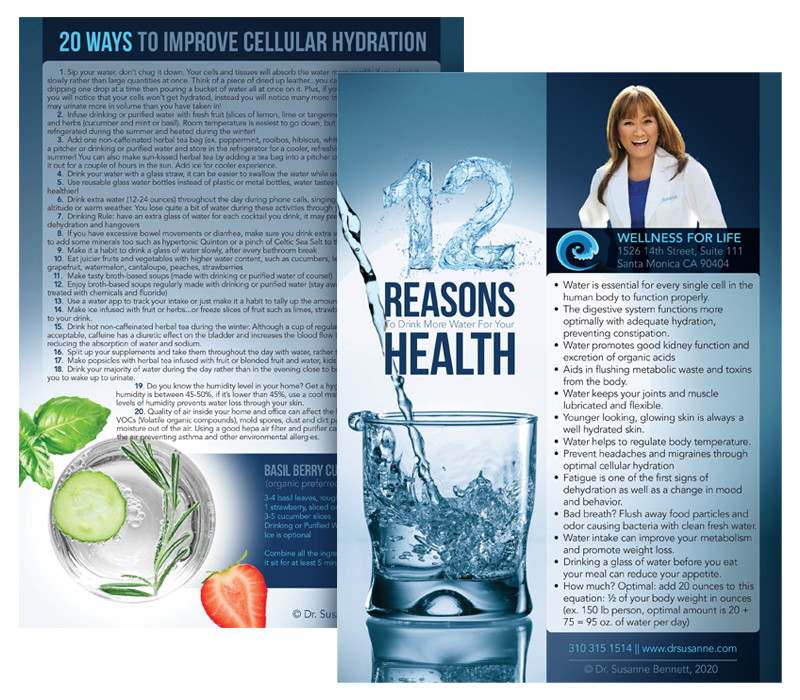Water seems straightforward. But at the molecular level, differing water from differing sources contains differing chemical and energetic content. This content creates a variety of responses as it interacts with our cells, and the behavior of the molecules will affect the way our bodies integrate nutrients and catalyze reactions. Let’s take a look at the attributes and upsides of our primary water types.
If you want watch the highlights video version and read the rest later, click here for the video! And here’s a link to the EPA document on how to protect the waterways that I reference in the video.
Tap Water
This is your literal run-of the-mill municipal water. Toilets, showers, dishwashers, kitchen sinks, laundry machines, sprinkler systems — the functional water we employ throughout the day. It’s considered drinkable in most regions of the United States, but also prone to a variety of additives and toxins such as chlorine, chloramines, fluoride, solvents, drug residues and heavy metals. This makes tap water a suboptimal source for ideal hydration and cell function, and it will often exacerbate issues related to fatigue and indigestion.
In worst case scenarios, tap water can be outright dangerous. Despite legislative measures, contaminants and pathogens do make their way into the local water supply (Think: Flint, Michigan), and these substances may include anything from trace amounts of aluminum, gasoline additive MTBE, pesticides and lead — to life-threatening levels of waterborne legionella bacteria (remember the 2014 Legionnaires Outbreak?)
Well Water
Though sometimes a reliable source of drinking water, well water these days should always be purified. Since it comes out of the ground, you may not be ingesting the added chemicals present in other processed water but, on the other hand, because it’s unfiltered, you’ll want to test it for bacteria, nitrates and chemicals and run it through a proper filtration system. So many pollutants unfortunately leech their way into groundwater and contaminate what would otherwise be a more useful method of water retrieval.
Well water often harbors a number of bacteria as well as parasites and, though the water status varies by site and location, its risks frequently supersede its benefits.
Mineral Water
Mineral water is spring water with extra minerals added to it. This type of water is crowded with extra material — but the good kind! Magnesium, calcium, sodium and potassium are trace substances in mineral water, but often want in higher supply. Mineral water is alkaline water and provides these natural components via the mineral spring it’s taken from, and tastes mildly saltier than other forms of water.
As a downside, mineral water is minimally filtered so there’s also an occasional risk of undesirable substances like mercury or arsenic finding its way in, and people with certain health conditions such as heart or neurological disease may actually be better off with a purer source of drinking water.
Distilled water
The exact opposite of mineral water, distilled water contains nothing extra. It’s been boiled and condensed back into its liquid state removing ANY additional substances. The good news is, there’s nothing in there to harm your health. It’s 100% H2O, so a good choice for purified clean water, but it’s also devoid of minerals to alkalize cells and improve hydration power.
While distilled water can be a good choice for diluting concentrated liquids as well as for hydrating infants and toddlers with pristine pure water, keep in mind that it does attract charged metals easily so you’ll want to monitor how you store it and what material it comes in contact with.
Avoid storing distilled water, or any liquids for that matter, in metal including stainless steel, brass, copper or aluminum containers, as well as plastic water bottles. The best types of water containers are glass bottles and jugs.
With no solutes, distilled water is extremely clean but involves a boiling and re-condensing process which takes a lot of time and electrical or gas power, so it tends to be impractical to carry out in your own home — and the expense of buying it bottled can add up fast! Distilled water only comes in plastic bottles, another good reason to find a better source of purified drinking water to reduce plastic exposure and minimize environmental impact.
Filtered vs. Purified Water
Water can be filtered through two different methods to remove chemicals and contaminants.
Filtered water means water has been filtered through a carbon filtration process. A carbon filter system costs less than a reverse osmosis or distillation unit and uses a filter that contains layers of charcoal and other adsorbents that can remove most impurities including dirt, fungi, bacteria, and other microbes.
However, the majority of carbon filtration systems only filter out particles up to 50 microns, and the most efficient only achieve .2 microns. This means it doesn’t take out heavy metals that are much smaller in size. They also tend to leave in fluoride, radioactive materials such as uranium, and the residues of medications, pesticides and solvents.
Reverse Osmosis (RO) Purification System employs a partially permeable membrane to separate water ions and harmful substances removing up to 99.9% of undesirable contaminants including toxic metals and fluoride by filtering particles as small as .00010 micron.
To give you an idea how small one micron is, it’s 1/1000 of a millimeter. An average strand of hair is 100 to 150 microns, pollen is 10 microns, bacteria can be as small as 1 micron, and viruses down to .001 micron.
The average size of heavy metals is .00015 microns, so small that it will absorb straight through the human cellular barrier– into your skin, eyes, nose, lungs and gut. This is why all humans have some level of toxic metals in our body, even newborns.
Therefore, RO purification system is the most effective process to make the cleanest of water with minimal energy consumption. This system is what I use in my own home and RV. Keep in mind that once tap water goes through the RO process, it does ten to drop the pH due to the removal of minerals, but there is a remedy for the acidity which I’ll share later in the series!
Glacier and Natural Spring Water
In the hierarchy of water, true spring or glacier water is the ultimate for its ideal molecular composition. When this water is actually glass bottled from the best natural springs and glaciers, it contains the minerals we need, and exhibits a proper electric charge, with undetectable levels of chemicals or heavy metals.
However, people who prioritize health and optimal hydration often grow frustrated that many springs tend to vary in their purity, and some of those name brand bottles can’t always be trusted. Additionally, buying your water supply in the form of bottled spring water is usually never financially feasible or environmentally appropriate.
Water experts have long looked for a way to take purified water and replace the hexagonal molecular structure interrupted by the reverse osmosis process. In the comforts of your own home, with a touch of a button, you can create delicious tasting, alkaline, structured water similar to unadulterated spring or glacier water for an affordable price.
In our next blog, The Possibilities of Structured Water, we’ll look closer at this form of structured, hexagonal water and its potential advantages in enhancing our lives by optimizing our physical systems and processes, beginning at the cellular level.







